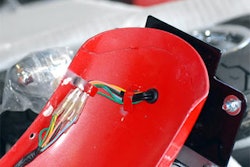As hydraulic fracturing, commonly known as “fracking” becomes more common, the industry waits for public understanding of this process to catch up to recent advances in the field. Here, we take a look at four common myths about fracking and drill down to find the truth.
1. Fracking is New
Although fracking has been making the headlines lately, it is not a new technology.
According to Tim Carr, a Marshall Miller Professor of Energy in the Department of Geology and Geography at West Virginia University, fracking has been in use on a wide-spread industrial level for horizontal drilling since the late 1970s.
What is new, however, its widespread use. “This is nothing new at all. What’s new about it is the scale,” Carr says.
According to New York Times reporter Ian Urbina, between 1990 and 2009 the number of natural-gas wells in the United States nearly doubled.
Today, according to the U.S. Energy Information Administration, the number of wells has leveled off somewhat, though the number of wells has grown by 5 percent since 2009.
Of the natural-gas wells in existence, 90 percent use fracking as a tool to increase gas flow.
2. Fracking is Dangerous
As with any method of energy production, fracking comes with a unique set of risks and complications.
Fracking injects enormous amounts of water, sand and chemicals like radium, benzene and sulphates deep into the ground, creating the potential for leaks, which can be risky.
These risks can be mitigated, however, with operation and oversight of wells using fracking as an extraction technique.
Paul Ziemkiewicz, Director of the West Virginia Water Research Institute, believes that the process itself is safe but has seen problems with leaks and well integrity.
“We’re seeing [problems] that come from…leakage getting into surface waters, and there have been reports of it getting into people’s drinking water wells,” Ziemkiewicz says.
If wells using fracking are properly regulated and operated, however, the process shouldn’t pose a long-term threat to surface water and water-table sources.
According to Ziemkiewicz, safe transportation and on-sight impoundment in addition to a well with a strong bore, proper lining, good steel integrity and safe cement work will pose little risk.
“Proper handling and good housekeeping at the well sights should eliminate most of those problems,” Ziemkiewicz says.
3. Manufactured Fracking Chemicals are Contaminating Ground Water
The chemicals used in fracking are found in nature. Reasonable concerns about these chemicals come not from the chemicals themselves, but rather their concentration and location.
The frack water initially injected into wells contains low levels of certain naturally occurring chemicals like benzene and radium, as well as sulphates.
When fracking waste water, or flowback, returns to the surface, it brings heavy concentrations of chemicals found deep within the earth.
“The concentrations of almost every contaminant are much higher in the flowback water and the produced water than in the injected frack water,” Ziemkiewicz says. “The contaminants that we see almost always increase during the flowback cycle.”
When this water is brought to the surface, it needs to be safely transported, filtered and recycled.
“It’s not what’s going on at 8,000 feet of depth [that poses contamination threats] — it’s what’s going on at the surface, and that’s where the concentration needs to be,” Carr says.
With safe, well-constructed wells, filtration is a fairly simple process. In addition, Most of the chemicals found in flowback are easily filtered.
The most prevalent pollution issue facing the fracking industry is the extreme salinity of flowback, and the difficulty in filtering that water.
“Reverse osmosis isn’t even really designed for this. It was designed to make sea water potable, and sea water is one-fourth to one-tenth as salty as flowback,” Ziemkiewicz says. “Any dissolved solids like salts will pass right through a filter, so you have to go to a very rigorous filtration process called either nanofiltration or reverse osmosis, which are really extreme, molecular-sized filters. They’re very expensive to operate.”
4. Fracking is Inefficient and Wasteful
Fracking uses enormous amounts of fresh water each year in order to increase productivity and harness the energy trapped in shale fields across the country.
But according to Ziemkiewicz, only 10 to 20 percent of this water can be recovered, and even after being filtered, it can’t be used as potable water.
“To treat that water to the point where you can discharge into a stream is a very rigorous and expensive process, and not many people are engaging in that,” Ziemkiewicz says. “As an alternative to that, most of that water is going to underground injection wells.”
In Pennsylvania, after attempting to integrate filtered flowback water into the city water system, the high levels of sulphates made the operation impossible.
“Pennsylvania was letting sewage treatment plants process flowback, but the salts were too high,” Ziemkiewicz says. “In May 2011, the governor restricted that practice, and concentrations of bromide and chloride and other salts have fallen.”
Although fracking requires an enormous amount of fresh water, the efficiencies are improving. Today, companies will filter and recycle almost all of their flowback water, using it for future wells in order to cut down on costs and water consumption.
As fracking becomes more prevalent, research and development in water filtration is advancing. Filtration techniques are becoming more energy efficient and more productive as demand rises.
Water filtration systems are showing signs of improvement. AquaTech’s Hybrid ZLD, or zero-liquid discharge, systems are a low-energy, high yield filtration systems that conserve water through energy-efficient equipment and environments.
Omni Water Solutions uses Hydro Innovation Purification Platform for Oil & Gas, or H.I.P.P.O., in order to filter produced water efficiently, creating either clean water for livestock and irrigation or brine for future wells.
On July 18, ThermoEnergy and STW Resources announced the successful pilot test of a water recovery system that filters produced water with a 72% fresh water recovery rate.
“This is a very new field. The whole Shell Gas production process in the Eastern United States is only 7 or 8 years old,” Ziemkiewicz says. “The technology and the practices are evolving very rapidly. I would expect that to continue.”























